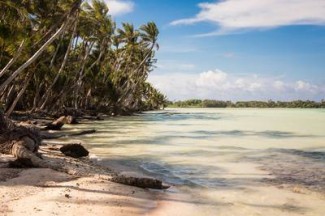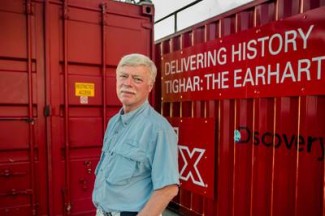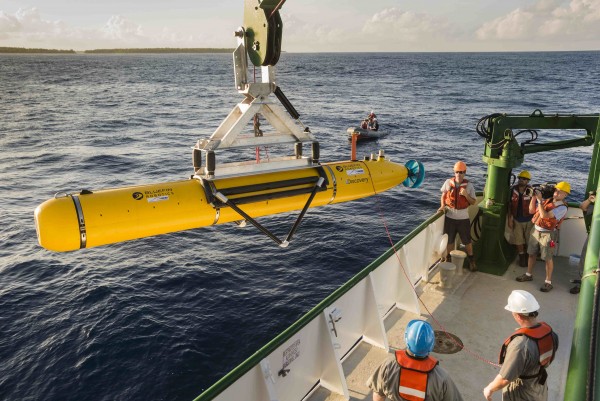TV RECAP: New evidence suggests discovery of Amelia Earhart’s lost plane

Discovery Channel’s new documentary, Finding Amelia Earhart: Mystery Solved?, is a tremendously interesting update on the search for Amelia Earhart’s Lockheed Electra aircraft. The one-hour program, which aired Sunday night, Aug. 19, follows a team of investigators as they leave Honolulu and head for the remote island of Nikumaroro, once known as Gardner Island. The International Group for Historic Aircraft Recovery, headed by Executive Director Ric Gillespie, has developed a sound theory that Earhart and her navigator Fred Noonan landed on Nikumaroro after failing to find their fueling target in the Pacific Ocean.
The evidence portrayed in the documentary is convincing. An archival photograph of a ship off the coast of the deserted island shows what appears to be the wheel from an aircraft sticking out of the water. Gillespie also cites that many remains and artifacts, including a woman’s shoe and buttons, have been discovered on the island. Perhaps most interesting is reexamined evidence of a distress radio call believed to have been received by a teenager in the United States after Earhart crashed. Listening for two hours, the young girl reported that the voice on the radio claimed she was “Amelia Earhart” and that the aviatrix kept repeating something that sounded like “New York City.”
Turning to Nikumaroro’s history, these statements from the young girl prove endlessly engaging. Maybe it wasn’t “New York City” that Earhart was saying, maybe it was “Norwich City,” the name of a freighter that had crash-landed on the island’s shore. The remains of the Norwich would still be on the beach of the island back in the 1930s.

Deciding to jump beyond circumstantial evidence, Gillespie and his team headed to the remote island just last month. Their findings (and lack thereof) are brought together for the Discovery Channel special.
The ultimate answer over what happened during Earhart’s attempted flight around the world remains a mystery. There have been countless theories over her fate, some believing she died after crash-landing, while others believing she survived the crash. Gillespie’s beliefs are based on fact and logical estimations. They’re not concrete, and Occam’s Razor tells us perhaps Earhart and Noonan simply crashed in the middle of the ocean, but there’s enough evidence to keep the search boats looking for more clues.
SPOILER ALERT!
There were two monumental obstacles to Gillespie’s recent expedition. Firstly, the sea floor off the coast of the island was not smooth or shallow. Instead, it dropped precipitously, handicapping the effectiveness of the team’s two camera devices. Secondly, the crash of the Norwich City has left many ship parts in the surrounding water. Every time Gillespie thinks he’s found something on the ocean floor, it turns out to be either a rock or a piece of the old freighter.

But perhaps there’s more on the ocean floor than first meets the eye. As the end credits begin to roll on the Discovery Channel special, the team’s most profound evidence is presented. After looking at the images the cameras were able to capture, researchers now believe there’s a good chance that airplane debris sits on the bottom of the ocean. The International Group for Historic Aircraft Recovery’s official web site reports that “a scattering of man-made objects on the reef slope off the west end of Nikumaroro” may have been found. The photographic evidence doesn’t look like much to the untrained eye, but for the researchers who study this type of footage every day, there’s great promise in these remarkable findings.
Gillespie’s team needs to take their Earhart project (Niku VII) back to the waters of the South Pacific. Before anything can disrupt this area, the evidence needs to be found and inspected. Earhart’s final mission still remains a mystery, but we’re probably closer to the truth than we’ve ever been before.
By John Soltes / Publisher / John@HollywoodSoapbox.com
-
Click here for more information.


definitly a gold mine of possibilities exist….
It seemed to me the main problem they were having was the pressure of
time…What are the time constraints for staying there longer than
the seven days…When you take all the problems they had with equipment
malfunctions….they’ve got to allow themselves more time..
Good luck…You’ve got me hooked on the possibilities…Bob
But She’s not there — the plane’s not there.
Amelia’s Lockheed Electra was within 75 miles of her target Howland Island when her radio cut out. Then the US sent nine ships, 66 aircraft, and well over 3,000 sailors and airmen. They covered well over 250,000 sq. miles of open sea and every island within a 650 mile radius of Howland.
US CGC Itasca Chief Radioman Leo Bellarts 30, was on watch that morning and said: “In the early morning, signals came in pretty good. I actually did go outside and stand right out the radio shack and thought I would hear a motor any second. Her voice was loud and clear; sounded frantic on her last transmission. Then it cut off.”
Amelia Earhart was an American heroine, a record-breaking aviatrix, and a celebrity world wide.
Earhart was not a spy — she was a decoy.
You Search for what you want to keep; you Hunt for what you want to catch.
Taken from, The Hunt For Amelia Earhart
Douglas Westfall, historic publisher, Specialbooks.com
‘Nikumaroro to Saipan’ I wrote this several weeks ago and it was published in the Opinion section of the Marienas Variety Newspaper.
IN the Amelia Earhart disappearance, there is a divide between those who think she landed on Nikumaroro Island and those who believe she ended up in Saipan. Not considering of course the long held view that she crashed into the ocean. Both seemed to have credibility.
As I contemplated these choices, I surmised that maybe both are right. It is well established that her radio transmissions for help continued for several days after her disappearance. I thought that the Japanese may have heard the signals with a radio direction finder and retrieved her. I had no evidence at that time, just the thought that it was possible.
I recently found some information that makes this scenario very likely. On the Internet, I discovered a publishers copy of “East to the Dawn” by Susan Butler. In her book, she tells of a Japanese journalist named Fukiko Aoki (she later became bureau chief for the Japanese version of Newsweek) who, in 1981, wanted to find out about the rumors that said Amelia Earhart had been executed in Saipan.
In her search, she interviewed Kozu Yukinao who had served as communications officer on the ship Koshu, which is believed to have been involved in finding Amelia Earhart and Fred Noonan. She also saw copies of the log for that ship. She made notes of the dates and places where the ship had been.
She stated that the Koshu received orders to help in the search for the missing plane. The next statement is what caught my eye! (Quoting from the book) “The Koshu headed south, out of Japanese and into United States waters, fully aware of where they were.” Checking the history of the territories, in that area south of the Equator, the only one under U.S. control, under the out-lining Island arangement, was the Phoenix Island group. (Britain was acquiring it at that time.)
If you travel SE from the North West corner of the Phoenix Island designation, about 440 miles (around 2 days travel), you come to an island called Nikumaroro! (Gardner) At some point the “Japanese superiors, uncomfortable at the idea that they were trespassing, as it were, ordered the ship back north.”
It is my opinion that:
1. The Koshu had heard Amelia’s transmissions and knew where to find the plane. It would make no sense to plunge in to a vast area of ocean to look for it without a good reason. (They were near the equator when they received the order.)
2. They may have put Amelia, Fred and the plane onboard before contacting the superiors and when they did reach them, got reprimanded and did not mention the new “cargo and passengers.” This could be why it was not in the log.
3. They had found them on an American Island may be why they didn’t report their find and why no effort was seemingly made to turn them over to the U.S. and also why Amelia and Fred were considered to be spies when taken to Saipan. The crew may have indicated they were found on a closer island like Mili Atoll to hide their secret.
From there they went to Jaluit and were there several days and then went to Saipan. From other sources we learn that while at Jaluit, Bilimon Amaron, a medical corpsman for the Japanese, was taken to the ship, Koshu, in the harbor to treat an American man and woman. He bandaged the man’s forehead. Bilimon told his brother at a later time that the man had some false teeth. Fred had taken a bad fall and broke out several teeth a while before the trip and his dentist had made a temporary bridge or plate to use till he got back.
DUANE HAMBLIN
Roy, Utah
They will never be found where TIGHAR continues to search. These expeditions will bear no fruit. For the truth, you must ask the Emperor…